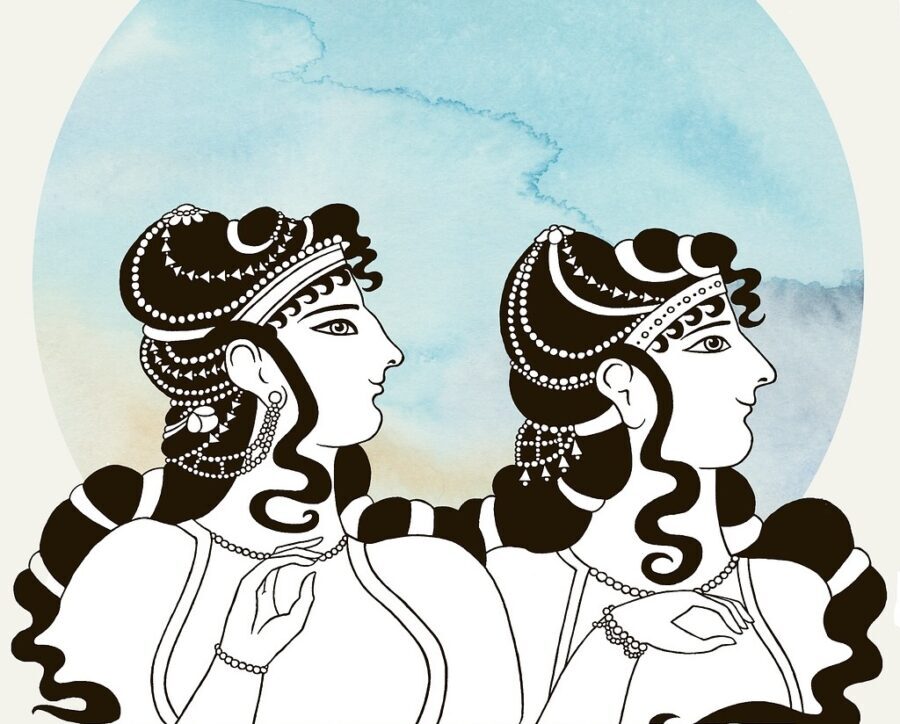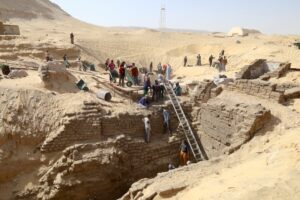
PHILADELPHIA, March 27, 2025—Penn Museum and Egyptian archaeologists working at Abydos in cooperation with the Egyptian Ministry of Tourism and Antiquities, discovered the massive tomb of an unnamed pharaoh at the ancient necropolis of Anubis Mountain, shedding new light on a long-lost dynasty and a lesser-known period in Egyptian history.
Found nearly 23 feet underground in January 2025, the impressive 3,600-year-old limestone burial chamber featured a decorated entryway and a series of other rooms capped by 16-foot-high mudbrick vaults. This marks the second major discovery of an Egyptian king’s tomb announced in 2025.
One of Upper Egypt’s most ancient cities, Abydos is located about six miles from the Nile River. Believed to be the burial place of Osiris, god of the netherworld, as well as a gateway to the afterlife, the sacred city also served as a royal necropolis—the preferred resting place of the first pharaohs, holding great significance for early Ancient Egyptian power structures and political development.
Although the king once buried in this tomb has yet to be identified, he reigned during the Second Intermediate Period (1640-1540 BCE)—a time of economic and political instability that yielded important social and technological changes when Egypt was broken into rival, warring kingdoms. One of these was the Abydos Dynasty, a series of kings who ruled part of Upper Egypt, first confirmed in 2014 during excavations led by Dr. Josef Wegner, Penn Museum Curator of the Egyptian Section and University of Pennsylvania professor of Egyptian Archaeology. He is also the Chair of Penn’s Department of Middle Eastern Languages and Cultures. In that year, his team uncovered the tomb of King Seneb-Kay, another Abydos Dynasty ruler.
Similarity in decoration and architecture between the tombs excavated in 2014 and 2025 has led Penn Museum archaeologists to conclude that the unknown ruler may have been one of King Seneb-Kay’s predecessors. Despite their comparable design, the newly unearthed tomb is much larger than that of Seneb-Kay or any other known ruler from the same dynasty buried there.
_____________________________

Penn Museum’s ongoing fieldwork at Abydos, Egypt has uncovered the tomb of an unknown king from a lost dynasty. Photo: Dr. Josef Wegner for the Penn Museum.
_____________________________
Hieroglyphic texts in yellow bands once recorded the king’s identity.
“The king’s name was originally recorded in painted scenes on plastered brickwork that decorated the entrance to the limestone burial chamber,” Dr. Wegner says. These paintings depict Isis (the ancient Egyptian goddess of motherhood and healing) and her sister Nephthys (often depicted next to Isis in funerary rites). “However, ancient tomb robbers damaged the hieroglyphic texts, and not enough survives to read the king’s name. There are several possible owners for the new tomb, including two kings named Senaiib and Paentjeni who dedicated monuments at Abydos but whose tombs remain unknown.”
According to Dr. Wegner, the tomb confirms there are additional early kings buried in, and around, the tomb enclosure of pharaoh Neferhotep I, a 13th Dynasty king who ruled a century before the Abydos Dynasty.
Excavations will continue through 2025 across this new focus area at Anubis Mountain, measuring roughly 10,000 square-meters (more than 100,000 square-feet) of desert terrain, using state-of-the-art technology such as remote sensing, magnetometry(magnetic mapping), and photogrammetry (three-dimensional modeling of the tombs).
“Ongoing excavations also include protection, site management, and conservation of these structures. That is a part of our commitment to the site in cooperation with the Egyptian Ministry of Tourism and Antiquities,” Dr. Wegner says. “Together, we have now opened King Seneb-Kay’s and King Senwosret III’s tombs as visitable monuments, and we’re in the process of opening other ones in the very same area where this new tomb was found. This discovery is a new window to understanding the origins of the enigmatic Abydos Dynasty.”
Dr. Wegner will discuss his work at Abydos at an upcoming virtual lecture Archaeology in Action, “Uncovering the Social and Political History of Ancient Egypt,” April 2, 2025 at 7:00 pm ET. Registration is open to the public.
With Dr. Jennifer Wegner, Dr. Josef Wegner is also co-curator of the highly anticipated Ancient Egypt and Nubia Galleries, the largest renovation in the Penn Museum’s 137-year-history.It is scheduled for completion in late 2026.
___________________________
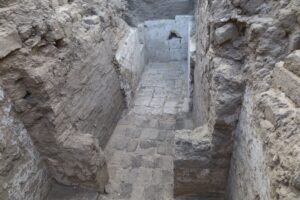
The 3,600-year-old limestone tomb chamber of an unknown king found by Penn Museum and Egyptian archaeologists working in Abydos, Egypt. Image: Dr. Josef Wegner for the Penn Museum Image: Dr. Josef Wegner for the Penn Museum
______________________________
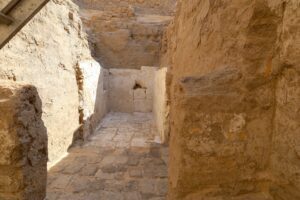
Found by Penn Museum and Egyptian archaeologists nearly 23 feet underground, the limestone burial chamber featured a decorated entryway. Image: Dr. Josef Wegner for the Penn Museum
___________________________
ABOUT THE ABYDOS ARCHAEOLOGICAL PROJECT
The Penn Museum’s excavations at Abydos began in 1967 and continue today. Home to the tombs of Egypt’s first pharaohs (3000–2800 BCE), Abydos was one of the most important religious centers of ancient Egyptian civilization.
Some 3,000 artifacts from Abydos are included in the Egyptian Section’s overall collection of more than 50,000 artifacts. Since 1994, the Penn Museum’s Egyptian Section has been excavating at the mortuary complex of pharaoh Senwosret III at Abydos. This 800-foot-long underground tomb at the foot of the desert cliffs was the first hidden royal tomb, marking a transition from the earlier pyramids.
ABOUT THE PENN MUSEUM
The Penn Museum’s mission is to be a center for inquiry and the ongoing exploration of humanity for our University of Pennsylvania, regional, national, and global communities, following ethical standards and practices.
Through conducting research, stewarding collections, creating learning opportunities, sharing stories, and creating experiences that expand access to archaeology and anthropology, the Museum builds empathy and connections across diverse cultures.
The Penn Museum is open Tuesday–Sunday, 10:00 am–5:00 pm. On first Wednesdays of the month, it is open until 8:00 pm. The Café is open Tuesday–Thursday, 9:00 am–3:00 pm and Friday and Saturday, 10:00 am–2:00 pm. On Sundays, the Café is open 10:30 am–2:30 pm. For information, visit www.penn.museum, call 215.898.4000, or follow @PennMuseum on social media.
__________________________
Advertisement
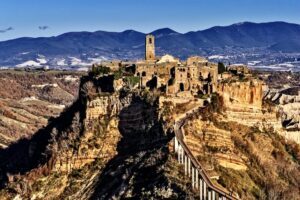
EXPLORE THE ANCIENT ETRUSCANS IN PERSON!
Experience a unique, up-close-and-personal hike among ancient hilltop towns in central Italy. You will walk the sensational countryside of the regions of Umbria and Tuscany, soaking in important sites attesting to the advanced Etruscan civilization, forerunners of the ancient Romans; imposing architectural and cultural remains of Medieval Italy; local food and drink; and perhaps best of all — spectacular scenic views! Join us in this collaborative event for the trip of a lifetime!

